Servicios Personalizados
Revista
Articulo
Indicadores
-
 Citado por SciELO
Citado por SciELO -
 Accesos
Accesos
Links relacionados
-
 Citado por Google
Citado por Google -
 Similares en
SciELO
Similares en
SciELO -
 Similares en Google
Similares en Google
Compartir
Ingeniería e Investigación
versión impresa ISSN 0120-5609
Ing. Investig. v.30 n.3 Bogotá sep./dic. 2010
Patricia Torres1, Camilo H Cruz2, Paola Patiño3, Juan Carlos Escobar4 y Andrea Pérez5
1 Sanitary Engineering, Universidad del Valle, Colombia. M.Sc., and Ph.D., University of São Paulo, Brazil. Associate Professor, Faculty of Engineering, Universidad del Valle, Colombia. patoloz@univalle.edu.co
2Sanitary Engineer, Universidad del Valle, Colombia. M.Sc., University of São Paulo, Brazil. Associate Professor, Faculty of Engineering, Universidad del Valle, Colombia. camcruz@univalle.edu.co
3 Sanitary Engineer, Specialist, Universidad del Valle, Colombia. Research Assistant, Universidad del Valle, Colombia. paopatin@univalle.edu.co
4 Sanitary Engineer, Universidad del Valle, Colombia. M.Sc., and Ph.D., University of São Paulo, Brazil. Chief Plant Operation Puerto Mallarino, EMCALI EICE ESP, Colombia. jcescobar@emcali.com.co.
5 Sanitary Engineer, M.Sc. Universidad del Valle, Colombia. Ph.D., (student) in Engineering Emphasis Area Sanitary and Environmental Engineering, Faculty of Engineering, Universidad del Valle, Colombia. andreaperezvidal@hotmail.com
ABSTRACT
Naturally occurring and anthropic contamination of water sources limits the use of water for human consumption. Fast and representative tools, such as water quality indexes (WQI), allow performing an integral assessment of the resource, this being essential when making decisions about the management and control of sanitary risks through different purification processes. A comparative analysis of applying WQINSF, Dinius WQI, ICAUCA and UWQI indexes at five points or stations on the Cauca River located in the Salvajina-Puerto Mallarino water uptake section, gave evidence of growing river deterioration due to the different socio-economic activities carried out in the river basin. This water quality condition brings about the incorporation of additional or specific treatment operations such as activated carbon or adsorption for the destination of the resource for human consumption. The presence of pathogens and particulate material were the variables mostly affecting WQI value. It is thus recommended that the development or adaptation of an index having a similar structure to the DQWI index should be considered to make a thorough river assessment and the additional use of soil which might generate the presence of other substances causing a sanitary risk in the source, considering variation in time and space of the parameters comprising it and its comparison with current legislation.
Keywords: sanitary risk, water quality index (WQI), water treatment.
Received: may 15th 2009
Accepted: november 15th 2010
Introduction
Demographic growth and industrial and agricultural development have increased the pressure on water resources, limiting their exploitation, due to the alteration of the physicochemical, microbiological and parasitological characteristics determining the complexity and costs of the treatment required for making water suitable for human consumption. One of the principles guiding water supply is the concept of multiple barriers involving source protection and optimisation of processes in water treatment plants and suitable distribution system management (Betancourt and Rose, 2004)
Raw water assessment must consider representative indexes guaranteeing integral analysis of water resources and allow action to be taken for management and control through different water purification processes. One of the most widely used tools is the water quality index (WQI). Such indexes lead to identifying tendencies related to changes in water quality and environmental specifications, helping governmental decision to be made and assessment of control programmes (Ott, 1978; Canter, 1998).
Indexes have been developed worldwide. One of the most widely known is the National Sanitation Foundation Index (WQI- NSF) which was developed by Brown et al., (1970) for United States rivers and has been applied and validated in several international studies. Dinius (1987) proposed a similar WQI, but suggested classification ranges based on specific uses apart from human consumption.
More recently, several specific WQI for assessing water resources intended for human consumption after treatment have been suggested and these include physicochemical and microbiological parameters related to the level of sanitary risk present in the water. Some examples are the WQI for public supply (IAP) in Brazil (CETESB, 2006), the Universal Water Quality Index (UWQI) (Boyacioglu, 2007) based on directives by the European Union and the Drinking Water Quality Index (DWQI) by UNEP (currently in review (UNEP, 2007)).
The IAP index considers parameters that require measurement techniques with detection limits too low to satisfy calculation specifications and the DWQI presents a calculation structure based on variation in time and space of the parameters comprising it and a comparison with current legislation according to studied use, which can favour the assessment of sources having wide quality variations in time and facilitating its application to the particular conditions of a region or country. However, the calculation requires information on every aspect of the index, collected during a long period of time (usually a year) (Torres et al., 2009).
The deterioration of the water resources in Colombia is mainly attributed to domestic, industrial and agricultural wastewater discharges and activities such as terrestrial, fluvial and maritime transport of hazardous substances or oil, mining extraction water and solid residue disposed of in sanitary landfills (IDEAM, 2001). Even though around 78% of the population has access to potable drinking water (ANDESCO, 2008), water quality issues regarding human consumption still prevail in some departments (Álvarez, 2008).
The Cauca River is the second most important water source for the country, as 25% of the population is located in its area of influence, including 183 municipalities in the basin spread over several departments: Cauca, Valle del Cauca, Quindío, Risaralda, Antioquia, Córdoba, Sucre and Bolívar (IDEAM, 2001). Several widely used indexes have been applied or adapted to this river. Rojas (1991) adapted the WQI-NSF to the specific river conditions wi special emphasis on water for human consumption following previous treatment and CVC and Universidad del Valle (2004) adapted a WQI from the WQI NSF, Dinius, CETESB and ICOSUS indexes, which was called ICAUCA.
A comparative analysis is made in this work of applying different WQI for assessing the water quality of the Cauca River as a supply of water for human consumption after treatment, in the Salvajina- Puerto Mallarino water uptake section and the influence on making decisions related to the viability of water use for purification.
Methodology
Sampling and source characterisation
The definition of the section and 5 sampling points or stations on the Cauca River was based on criteria relative to the pattern of historical information regarding water quality in this section and localisation on the main tributaries discharging into the river. WQI assessment was based on the information collected from 3 samplings carried out at 5 selected points during a 9-month period to characterise different weather and river quality conditions. Each sampling point involved 3 samplings taken in the transversal section of the river at each point, except for dissolved oxygen and coliforms for which instant samples were taken in the middle point of the section.
Figure 1 shows the location of the selected sampling points and Table 1 shows the measured parameters and the analysis techniques considered according to APHA et al., 2005.
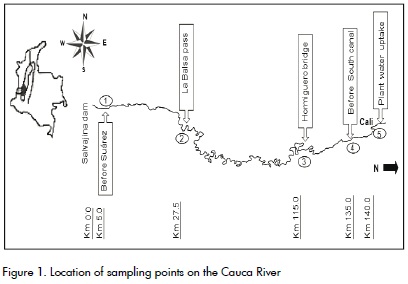
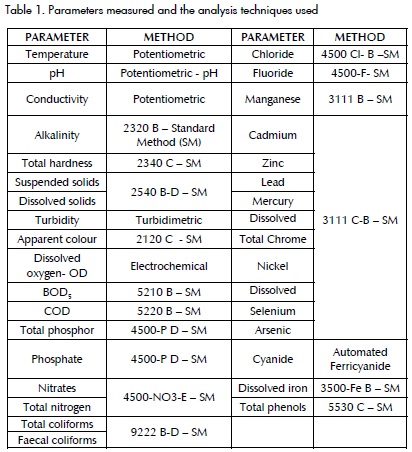
Water quality indexes
Based on a literature review and some known basic characteristics of the section to be studied, four WQI were selected according to the following criteria: broad application at international level, classification considering the destination of the resource for public supply and being representative of the study's local conditions.
Table 2 shows the selected WQI with their respective calculation equations and some observations related to the equations.
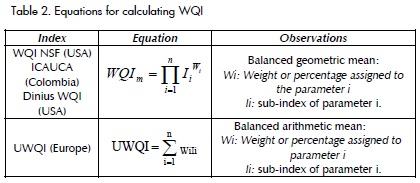
WQI was calculated by means of a series of stages:
- Estimating "Ii" sub-indexes corresponding to non-dimensional transformation of each parameter forming the WQI by means of curves or equations. "Ii" figures varied between 0 and 100, the higher the figure the better the water quality;
- Assigning the relative weight (Wi) defining the importance of each parameter in the assessed WQI and its relationship to the use to be evaluated; the sum of all weights must equal 1. As a general rule, the parameters having the highest weight were e dissolved oxygen, coliforms and those associated with the presence of organic matter such as BOD. Table 3 presents the assigned weighting for the parameters comprising the WQI; and
- Calculating the selected WQI from the values obtained for "Ii" and "Wi" in each case.
Results and Discussion
Cauca River characterisation in the Salvajina-Puerto Mallarino water uptake section
Table 4 presents the average values for the physicochemical and microbiological characteristics in the river and the defined limits, according to current Colombian legislation (Decree 1594 - Ministry of Health, 1984 and RAS - Ministry of Development, 2000) for water for human consumption subjected to conventional treatment.
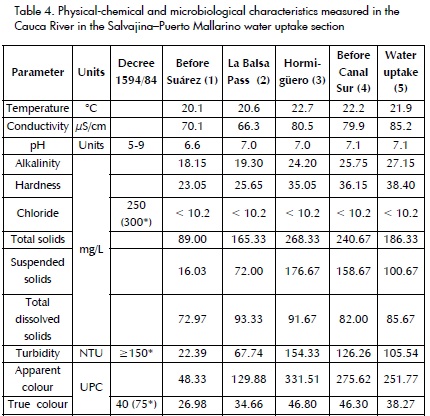
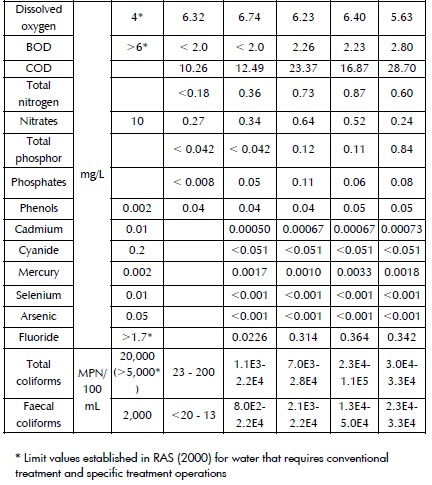
* Limit values established in RAS (2000) for water that requires conventional treatment and specific treatment operations
As observed in the above Table, the physicochemical characteristics were below established limit values excepting for phenols which were above them (0.002 mg/L) in the studied section of the river. Such high phenol concentration makes additional water treatment necessary and purification plants in the city of Cali have implemented activated carbon dust adsorption (CDA) to reduce the presence of phenol compounds in the river water (Torres et al., 2008).
The characteristics of the sampling ports allow identifying three sectors:
Sector 1: Salvajina dam - Station 1: had figures similar to those usually reported for good quality superficial sources, associated with settling phenomena and dilution in the Salvajina dam and not much influence of domestic or industrial wastewater discharges.
Sector 2: Station 1-2: an increase in suspended material and pathogen levels was observed that affected river water quality. This increase could be attriuted to wastewater discharges originating from population settlements along the river as well as the contribution of particulate material from the Ovejas and Timba rivers.
Sector 3: Stations 2 - 5: presented characteristic values for surface water having notorious water quality deterioration associated with increased agricultural, industrial and urban activities in the sector. The Hormiguero station registered the highest values of suspended solids, turbidity and apparent colour, possibly due to the influence of the Palo, Zanjón Oscuro and Jamundí rivers which present issues related to erosion in their basins.
An important aspect, which must be pointed out, was the high COD and low BOD levels characteristic of low organic contamination(<2 mg/L - UNESCO, 1996). This condition could indicate that inorganic oxidable substances are being discharged into the river, thereby increasing COD concentration and could negatively influence the chemical risk present in the river.
Regarding pathogen behaviour, total and faecal coliform levels wer well above the limits for water intended for human consumption after conventional treatment after Station 2 which directly influences the level of acute risk present in the water and is determinant in the supply of safe water to the population. This makes controlling the treatment systems supplied by the source an urgent priority. Purification water plants in Cali which are supplied by this source have implemented pre- and post-chlorination as a microbiological risk control measure to deal with this situation.
Comparing the results obtained here with previous studies by CVC and Univalle (2004) it was observed that the figures presented in the section being studied are characteristic of the river, mainly during winter and transition weather conditions in which the river has increased dilution capacity. This was reflected in the low concentration of parameters such as BOD and high OD levels. The contrary occurred for parameters associated with the presence of particulate and dissolved material (total suspended solids, turbidity, apparent colour, iron and manganese) which have increased due to soil material drag and the river bed.
It should be noted that there were no extreme contamination events during the sampling period ( mainly associated with OD levels lower than 2 mg/L or turbidity higher than the limit value established for water treatment in the treatment plants of the city of Cali which are supplied from Cauca River, i.e. 3000 UNT). Such high turbidity events eventually take place in the surroundings of Puerto Mallarino water uptake and affect the continuity of water supply to nearly 80% of the population of the city of Cali due to purification delay (Univalle and EMCALI, 2009). Strong rains falling in the Palo River basin produced landslides and bank erosion during February 2009, thereby increasing Cauca River turbidity levels to 10,000 UNT in the Puerto Mallarino water uptake section.
Applying water quality indexes
Figure 2 shows the average pattern for the WQI being assessed. It was observed that according to WQI-NSF, the river had good quality at station 1, regular quality at station 2 and poor quality at the rest of the stations which reported the lowest figures (39-55). This classification agreed with that for the 3 previously described sectors.
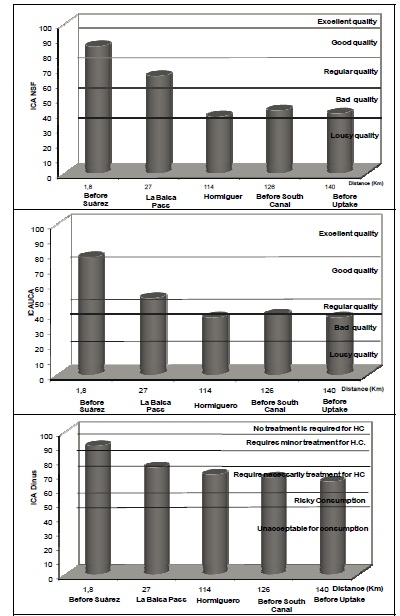
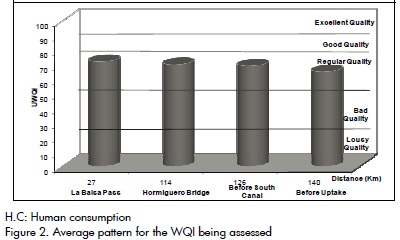
ICAUCA had a similar tendency to WQI-NSF, However, according to the established classification ranks for this index, the river had good quality at stations 1 and 2 (70-60) and acceptable quality at stations 3, 4 and 5 (40.6-41.9). It was also noticed that ICAUCA assigned an important relative weight to the group of parameters related to the presence of particulate material in suspension (a problem mainly associated with the basin during winter); the classification was similar to other assessed WQI.
The Dinius WQI indicated that river water required treatment for human consumption at all stations. However, with increased waste water discharge into the river in its trail, the index decreased and this influenced complexity and treatment costs. As with the WQI-NSF and ICAUCA, the lowest values were presented at the last 3 stations in the section being assessed.
The UWQI was not assessed at the Suarez station as no information on all the parameters required was available for making calculations. Although this index includes parameters related to chemical risk in the water due to the presence of selenium, arsenic, cyanide, cadmium and fluoride, the obtained results did not show these parameters' strong influence on the final value and classify the river as having regular quality throughout the studied section. This situation could indicate that the river presented a low chemical risk associated with sanitary interest substances considered by the index; however, for a thorough and integral assessment of the risk, the possibility of adapting an index must be considered which includes other substances being dumped which are related to the socio-economic activities predominating in the basin such as pesticides, phenols and other metals.
The assessed WQI reflected the deterioration of river water quality, mainly at stations 3, 4 and 5, and this deterioration was strongly influenced by domestic, industrial and agricultural wastewater discharge, directly or through tributary rivers. The variables that affected water quality the most were pathogens and those associated with the presence of particulate material. Also, the values obtained for the assessed WQI were quite similar to those registered in previous studies by CVC and Universidad del Valle (2004) having figures in the calculated range based on the historical tendencies reported by CVC during 1993-1997 and 1998-2002.
The obtained figures were similar to those reported by CETESB (2006) regarding water quality assessment of interior streams in the state of São Paulo in Brazil, mainly in sectors influenced by residual water discharges from medium and large populated areas located in the basins. The assessment led to classifying water quality as regular according to WQI- CETESB, which is an adaptation of WQI-NSF. It was observed that one of the parameters having the most influence on final WQI figures was faecal coliforms, as reported by Álvarez et al., (2006) when assessing water quality by WQINSF in the Amajac river basin in Mexico.
Conclusion
Assessment of water quality along the studied section of the Cauca River showed progressive deterioration so that three sectors were identified; the first had good quality river water, the second had an increase in pathogens and particulate material due to the presence of domestic and agricultural water discharge and the third had surface water characteristics with increased deterioration in quailty, mainly due to domestic, industrial and agricultural activity in the sector and inappropriate tributary source management which, besides producing contamination problems due to anthropic activities, presented erosion.
The assessed WQI confirmed growing Cauca River water quality deterioration with increasing socio-economic activity in its basin. The river presented overall regular to bad quality so that it must be treated for human consumption and even the incorporation of specific treatment operations such as activated carbon adsorption. The section presenting the lowest figures for the indexes lies between Hormiguero and Puerto Mallarino water uptakes.
The high impact of pathogen microorganisms and particulate material on final WQI figures pointed out the immediate need to apply efficient trategies for domestic and agricultural discharge management and controlling sub-basin erosion to improve water quality in this important water source for the country and mainly for south-western Colombia.
Due to the high variability and complexity of Cauca River quality and its necessary use as a water source for supplying a vast number of populations besides the city of Cali, an index must be developped or adapted including representative parameters for the presence of substances causing sanitary risks in this source, such as phenols, true colour and pesticides. This index should have a similar structure to the DWQI which considers variations in time and space of the parameters comprising it and comparing these with current legislation, so that more integral river assessment can be carried out.
Acknowledgments
The authors wish to thank COLCIENCIAS and EMCALI EICE ESP for technical and economic support and the Universidad del Valle for developing this study.
Álvarez, G., Calidad de Agua., Dirección General de Salud Pública, Ministerio de Protección Social, Memorias del Foro internacional del Agua, Bogotá, 2008. www.minambiente.gov.co /contenido/contenido.aspx?conID=1945&catID=514 [ Links ]
Álvarez, A., Rubiños, J. E., Reyes, F.J., Alarcón, J.J., Hernández, E., Ramírez, C., Mejía, E., Pedrero, F., Nicolás, E., Salazar, E., Índice de Calidad del Agua en la cuenca del río Amajac, Hidalgo, México: Diagnóstico y Predicción., Revista Internacional de Botánica Experimental, Vol. 75, 2006, pp. 71-83. [ Links ]
Andesco., Retos del sector empresarial para el desarrollo y mejoramiento del sector de agua potable y saneamiento en las regiones., Memorias del Foro internacional del Agua, Bogotá, 2008. www.minambiente.gov.co/contenido/contenido.aspx?conID=1945&catID=514 [ Links ]
APHA, AWWA y WPCF., Standard methods for the examination of water and wastewater., U.S.A, 20th ed., 2005. [ Links ]
Betancourt, W., Rose, J., Drinking water treatment processes for removal of Cryptosporidium and Giardia., Veterinary Parasitology, Vol. 126, Dic., 2004, pp. 219-234. [ Links ]
Boyacioglu H., Development of a water quality index based on a European classification scheme., Water SA, Vol. 33, No. 1, Ene., 2007, pp. 101-106. [ Links ]
Brown, R., Macclelland, N., Deininger, R., Tozer, R., A Water Quality Index - Do We Dare?. Water and Sewage Works, Vol. 11, Oct.,1970, pp. 339-343. [ Links ]
Canter, L., Manual de evaluación del impacto ambiental. Técnicas para la elaboración de estudios de impacto., Mc Graw Hill (ed.), Madrid, España, 1998, pp. 154-162, 231-294. [ Links ]
CETESB -Companhia de Tecnologia de Saneamento Ambiental-., Relatório de qualidade das águas interiores no estado de São Paulo. Anexo V. Brasil. 2006. www.cetesb.sp.gov.br [ Links ]
CVC, Universidad del Valle., Estudio de la calidad del agua del río Cauca y sus principales tributarios mediante la aplicación de Índices de Calidad y Contaminación., Proyecto Modelación del Río Cauca (PMC), Fase II, Cali, Valle., Vol. X., 2004. [ Links ]
Dinius, S. H., Design of an Index of Water Quality., Water Resources Bulletin, Vol. 23, No. 11, 1987, pp. 833-843. [ Links ]
IDEAM - Instituto de Hidrología, Meteorología y Estudios Ambientales., El Medio Ambiente en Colombia., Bogotá. 2da ed., Bogotá, IDEAM., 2001, pp. 151-156. [ Links ]
Ministerio de Salud., Decreto 1594 de 1984., Colombia, 1984. [ Links ]
Ministerio de Desarrollo Económico., Reglamento Técnico del Sector de Agua Potable y Saneamiento Básico - RAS 2000., Colombia, 2000. [ Links ]
Ott, W. R., Environmental indices: Theory and practice., Ann Arbor Science Publishers (ed), Michigan, 1978. [ Links ]
Rojas, O., Índices de Calidad del agua en Fuente de Captación., Memorias Seminario Internacional sobre calidad del agua para consumo, Cali, ACODAL. 1991. [ Links ]
Torres, P., Cruz, C.H., González, M., Gutiérrez H.M., Barba, L.E., Escobar, J.C., Delgado, L. G., Reducción del Pentaclorofenol en el agua cruda del río Cauca mediante adsorción con carbón activado en procesos de potabilización., Ingeniería e Investigación, Vol. 28, No. 3, Dic., 2008, pp. 92-95. [ Links ]
Torres, P., Cruz, C.H., Patiño, P., Índices de calidad de agua en fuentes superficiales utilizadas en la producción de agua para consumo humano., Una revisión crítica., Revista Ingenierías Universidad de Medellín, Vol. 8, No. 15 suppl.1, Jul., 2009, pp.79-94. [ Links ]
UNEP -United Nations Environment Programme-., Global Drinking Water Quality Index Development and Sensitivity Analysis Report. Ontario, Canada. 2007. www.gemswater.org [ Links ]
UNESCO., Water Quality Assessments, A guide to the use of biota, sediments and water in environmental monitoring., Chapman and Hall (ed), Londres, E & FN Spon., 1996, pp. 59- 108. [ Links ]
UNIVALLE y EMCALI., Fortalecimiento de las Capacidades analíticas para Identificación de Riesgos sanitarios en el Agua cruda del Río Cauca y Aplicación de Estrategias para la Minimización del Riesgo en los Procesos de Potabilización., Proyecto de investigación, Cali, 2009. [ Links ]











 texto en
texto en 


